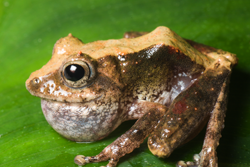Project will digitize, file animal sounds
LAWRENCE — Once, during a night time trek through a remote patch of Philippine rainforest to record frogs and collect their eggs for his doctoral dissertation, University of Kansas researcher Rafe Brown found himself alone, far ahead of his colleagues on the trail.
 That’s when his headlamp died.
That’s when his headlamp died.
“I had to sit on a log for an hour in the dark,” Brown recalled. “Already, I’d spent a couple of hours trying to record all the frogs in the area, and I was pretty sure there were just three species. But when forced to just sit there and listen to them, I found that there were seven or eight different calls in the area.”
Such is the importance of sound to biologists and naturalists: It can help distinguish one species of animal from another, even when two species might look nearly identical.
That’s one reason why scientists for generations have lugged recording gear into the field, capturing all manner of animal signal, from croaking frogs to chirping insects to singing birds. Unfortunately, over the years, many hard-won recordings have moldered on back shelves of museums and offices, often in outdated audio formats, such as reel-to-reel tape.
Today, Brown is an associate professor of ecology and evolutionary biology and curator-in-charge of the herpetology division of the KU Biodiversity Institute. In that role, he is helping to lead a new, $200,000 effort, funded by the National Science Foundation, to digitize, archive and make available thousands of field recordings of animal sounds at KU, and tie them with the voucher specimens that were recorded.
“In the past, if someone wanted to get a call of a recording of a species of frog from Central America that was recorded 30 years ago, it was a complicated process,” said Brown. “They’d have to contact us, and one of us would have to go back and try to sift through all the material to try and find the tape and the segment of the tape with the frog, and then record it to a cassette tape and send it to them.”
The KU researcher said the new grant would upgrade data accessibility for the Internet era.
“The idea is to take all off this ancillary material and put it online,” said Brown. “You’ll go look at the record for the frog, and you’ll see there are digital photos of it and its habitat, and then you can click on a link and instantly hear the sound that it made.”
KU is one of a consortium of 11 research institutions to digitize audio recordings through this effort. Other major contributors include the Smithsonian, Louisiana State University’s Museum of Natural Science and the Texas Natural Science Center at the University of Texas at Austin. The work at KU’s Biodiversity Institute will focus on the strength of its herpetology and ornithology collections, the latter of which is curated by co-investigator Mark Robbins.
Ultimately, Brown said the grant would speed the process of discovering, cataloging and naming species for academic researchers and naturalists. Also, many of the animal sounds will be made available to the public, helping to underscore the importance of sound to biology — and conveying the mysteries of animal communication.
“Species are making sounds to mark their territory, to attract mates, to scare away predators, to call to their offspring, and even in some cases to send signals to other species,” Brown said. “And there are things that people still debate. Why do birds sing at dawn? Are they marking their territory? Are they happy that the sun is up and making noise because they can? There still are questions about why organisms make sounds, sometimes in a context that we can’t really understand.”
The project, which will fund several new positions for graduate students and postdoctoral researchers, should run through 2017.